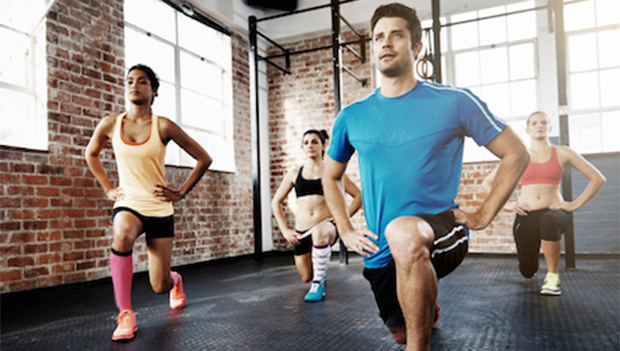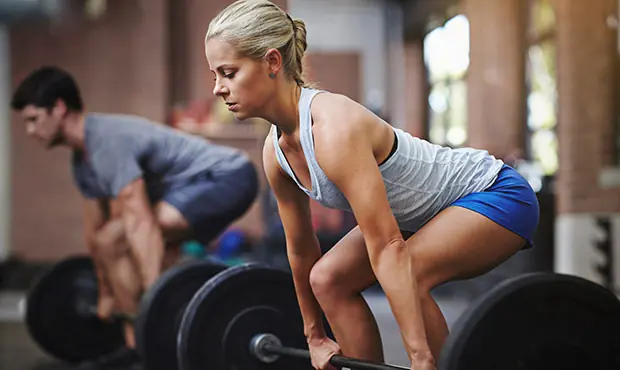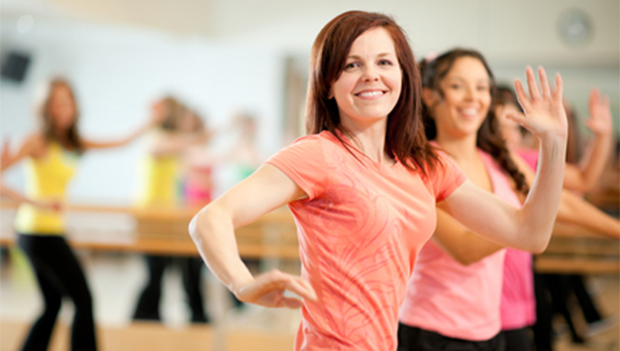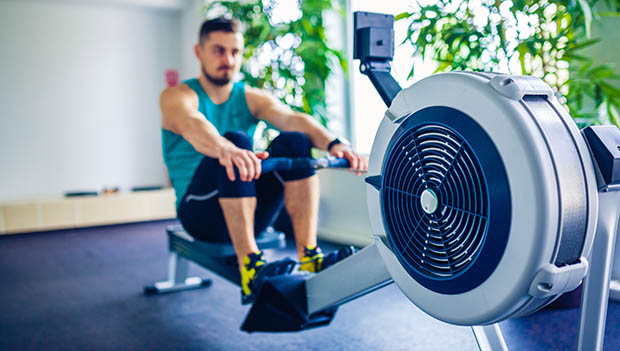
By clicking on the product links in this article, we may receive a commission fee at no cost to you, the reader. Sponsorships and affiliate commissions help support our research so we can help you find the best products. Read full affiliate disclosure here.
As a certified Gen X'er, the word aerobic instantly conjures up thoughts of neon leotards, slouchy leg warmers, and smiling people energetically bouncing around to Jane Fonda's instructions. While the refrains of single, single-double, and kick, ball, change don't ring through the air as frequently as they did during my childhood, it doesn't mean that aerobic exercise has gone the way of shoulder pads (please don't bring those back).
Nowadays, we just usually call it cardio. And when it comes to cardio, there are 4 primary machines you can use in your home to get your blood pumping.
So, What Exactly is Aerobic Exercise?
The term aerobic means "with oxygen." Essentially, when we're engaged in cardio or aerobic activities, we send oxygen to our muscles at a faster rate. This helps them move and burn fuel. The higher our aerobic capacity, the more efficiently and effectively our muscles work. When we engage in aerobic activity, we utilize more oxygen as our heart rate increases in order to supply that oxygen quickly back to our body.
What's in it for Me?
The benefits you gain from getting your cardio in are as long and varied as the number of activities that get that heart pumpin' and that oxygen flowin'. According to the Cleveland Clinic, aerobic exercise improves cardiovascular conditioning. A well-conditioned cardiovascular system decreases the risk of heart disease and improves lung function.
Aerobic exercise also helps you lose and maintain weight. Additional benefits of regularly engaging in these types of activities include decreased risk of heart disease, lower blood pressure, better control of blood sugar levels, and decreased heart rate.
Let's Get Ready to Rumble: Aerobic v. Anaerobic
Although your breathing and heart rate increase when engaged in aerobic activity, it's at a clip that you can maintain for a sustained period of time. You're still sure to get sweaty, and because your ticker is beating faster, you'll have increased blood flow to your muscles. In activities such as running, biking, or practicing breaststroke, we rely heavily on oxygen to provide the energy needed to sustain us over a relatively long period of time. However, the pace and the amount of time that you can last are determined by your overall fitness level and other circumstances.
Aerobic exercises are like a tried-and-true workhorse—not particularly flashy, but they get the job done in a reliable, steady fashion. Whereas anaerobic activities can be thought of like the Kentucky Derby racers: These activities are short, fast, and intense. Your body needs immediate energy for anaerobic exercises, and this is mainly derived from breaking down glucose rather than oxygen. Anaerobic activities typically last from a few seconds to two minutes. After the two-minute mark, your muscles will need to call in some oxygen reinforcements.

Gettin' Down to Business
Now that we have the basics of what constitutes aerobic exercises and how they differ from their more flamboyant counterparts (looking at you anaerobic exercise), let's get into some specifics and break down what you need to become an aerobic wizard—snazzy leotards optional.
Running
- Equipment: Running shoes, athletic socks, shorts/leggings, sweat-wicking shirt
- Benefits: Aids in losing weight and keeping it off, reduces stress levels, improves cardiovascular health and aerobic capacity, builds muscle, increases bone density
- Duration and frequency: Considering that running puts your body under a great deal of biomechanical stress, it's recommended that you only run three to four times a week on alternating days. When determining the amount of miles that you run, your overall fitness level, additional aerobic exercises that you're performing, and any specific training goals should be taken into account.
- If you are a beginner: It's important for beginners to not start out too hot. Rather, it's better to build slowly by implementing a 2:1 walk/run ratio, such as walking for one minute and running or jogging for 30 seconds. Beginners should limit themselves to running two to three times per week until they have sufficiently built up their cardiovascular and muscular endurance.
Swimming
- Equipment: Swimming suit, goggles, cap, pool, or other body of water Benefits: Full body workout that increases heart rate without stressing the body. Swimming builds and tones muscles and is also great for increasing your endurance. Lastly, it burns a crazy number of calories.
- Duration and frequency: Since swimming is low-impact and doesn't cause a lot of stress to the body, you can do it fairly frequently (four to five days per week) for 30 to 45 minutes at a time. Please make sure that you follow proper water-safety protocol.
- If you are a beginner: Those new to swimming may want to take a swimming class to learn proper strokes and breathing techniques. Beginner swimmers should limit their laps to two to three days a week, and they can also implement a kickboard into their routine.
Dancing

- Equipment: Space to groove, specific shoes depending on the type of dance, comfortable clothes
- Benefits: The various moves associated with dance challenge your heart rate while building your strength and improving your balance. Additionally, the movements combined with music can boost your mood.
- Duration and frequency: We recommend that you shake your groove thing every day. However, when it comes to high-intensity dance such as those found in Zumba or hip-hop classes you may want to limit yourself to 30 to 45 minutes, about four to five days per week.
- If you are a beginner: Those new to dance can slow down the movements by performing them at half speed. As your endurance increases and the movements become more familiar, you can step in time.
Jumping Rope
- Equipment: Jump rope (properly sized), supportive sneakers
- Benefits: Jumping rope is a great cardio workout that also builds leg muscles. It's versatile in that you can basically make it as hard or as easy as you would like. Additionally, it aids our coordination and agility, while giving us more explosive power.
- Duration and frequency: Jumping rope is both a great warm-up to your workout and a great workout in and of itself. If you're vigorously jumping, try logging about 75 minutes over the course of a week. That equates to about 15-minutes of rope jumping for five days a week.
- If you are a beginner: Jumping rope can elevate your heart rate quickly, therefore beginners should start out slowly, both in the speed of jumping and the amount of time. If you are intermediate or advanced, try a weighted jump rope.
Cycling
- Equipment: Bike, cycle shoes, padded shorts, helmet, and reflective gear (if cycling outdoors)
- Benefits: Improves your cardio fitness while increasing leg strength. Additionally, if you're pumping your legs to some tunes in an indoor cycling class or feeling the sun on your face when pedaling outside, cycling can be a great stress reliever and a mood booster. Plus, if you cycle to work (or other places) rather than drive, you're helping the planet as well.
- Duration and frequency: Cycling is low-impact cardio training so the amount and frequency in which you pedal are largely determined by your overall fitness level. High-intensity cycling can really jack your heart rate up, so keep that to about 20-minutes a day until you've built up some time in the saddle.
- Modifications for beginners: If you're new to cycling outdoors, please be cognizant of the rules of the road. Also, it's of the utmost importance for you to be safe by wearing a helmet and reflective gear, especially when visibility is low.
Other Cardio Exercises:
- HIIT (High-intensity interval training)
- Kickboxing
- Rowing
- Hiking
- Burpees
- Squats

Final Takeaway
Aerobic exercises abound—performing them helps both our physical and mental well-being. Given that many of them don't require expensive gear, it's very easy to get started or build on your current cardio routine. Try out some of the options listed in our guide and enjoy the cardio burn that follows.
Aerobic Exercise | Cardio Workouts | Best Jump Ropes | Best Compact Cardio Equipment | Best Cardio Machines | 30-Day Cardio Challenge
Get ACTIVE on the Go


Couch to 5K®
The best way to get new runners off the couch and across the finish line of their first 5K.
Available for iOS | Android





Discuss This Article